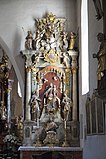Our Lady (Gauting)
The Catholic branch and former pilgrimage church of Our Lady (also called upper church ) in Gauting , a community in the Upper Bavarian district of Starnberg , was started in the 15th century, the nave was expanded in the 18th century. The church has preserved frescoes from the 15th century and from the Renaissance and early Baroque periods . The building is on the list of protected architectural monuments in Bavaria.
history
The Gautinger Frauenkirche was built on a former Roman road on the site of a previous Romanesque church. The church was first mentioned in writing in 1402. The current church was completed by 1489, as evidenced by the stonemason mark of the master builder Silvester Schöttl from Holzkirchen in the arch of the eastern choir window and the year 1489. The lower part of the tower still comes from the previous building erected in the 12th to 14th centuries, which was destroyed by Duke Ludwig VII during the Bavarian War ( Milk War ) in 1422 .
architecture
In the northern corner of the choir rises the undivided bell tower covered with a gable roof, which is broken through on its north and south side by two pointed arches of sound arcades and which still has Romanesque structures on its ground floor. The west facade is windowless. The entrance is in the sign attached to the south side . The nave , a wide, flat-roofed hall building , is divided into two axes . It opens through a wide pointed arch to the drawn-in choir closed on three sides . The chorus is dreijochig and from one to services resting network vaulted cover which forms a continuous series of diamonds in the apex.
Frescoes
In the course of an extensive restoration in 1961/62, frescoes from the Renaissance and early Baroque periods were uncovered in the choir. The scenes from the life of the Virgin Mary on the walls and the vaulting in the chancel date from around 1600. On the north wall of the nave, in front of the gallery , there is a monumental, almost four meter high depiction of St. Christopher , which is dated to the time the church was built.
Furnishing
- The miraculous image of an enthroned Mother of God with a scepter and child Jesus, a carved figure from around 1480, is integrated into the high altar from 1683 ; St. Dominic is depicted on the left, St. Catherine of Siena on the right and the Trinity in the altarpiece . On the side of the altar are the figures of St. Joseph (left) and St. Anthony of Padua (right), both of whom hold the baby Jesus in their arms.
- The north side altar was made in 1743 by Johann Georg Greiff as a replacement for the Anne Altar from 1682, which had burned down three years earlier. In the middle, the instruction of Mary by St. Anne is shown, on the left stands John the Baptist dressed in a fur and a lamb at his feet, on the right the evangelist John with his attribute , the eagle. Saint Joachim , Anna’s husband and Maria’s father, floats in the excerpt , flanked by the plague saints Sebastian and Rochus von Montpellier . The bust of Pope Silvester I is on the cafeteria . The painting on the antependium depicting the marriage of Anna and Joachim probably comes from the previous altar and was executed by Josef Dersch.
- The southern side altar was made after the completion of the northern side altar with a similar structure around 1745 in the workshop of Johann Baptist Straub . In the center of the altar, Saint Joseph is depicted with the baby Jesus, to the side are Saint Anne (left) with a book in her hand, on which two doves are sitting, and Saint Barbara (right) who is looking at her attributes, the chalice and the sword, can be seen. In Altar extract floats John Nepomucen , the two smaller figures, St. Benedict , the patron of the Gauting Parish , and Acts James, The Elder , which is characterized by its shoulder bag, Pilgrim and bar as a pilgrim. The bust on the cafeteria depicts the apostle Judas Thaddäus .
- Under the choir arch , surrounded by a rosary , hangs a crescent moon Madonna from around 1660, a late work by Georg Wunderl from Wolfratshausen. At the top of the rosary is the dove of the Holy Spirit , on the tondi the hands and feet of the crucified one are depicted.
- The pulpit dates from the same time as the side altars. The sound cover is crowned by a figure of the Archangel Michael , who weighs the souls of the risen. The pulpit is decorated with symbols of the evangelists .
- On the north wall of the nave, next to the staircase to the pulpit, there is a baroque, wood-carved mercy seat (without the dove of the Holy Spirit), which comes from the estate of a Gauting family.
- The red marble tombstones from the 16th and 17th centuries belonging to the Dichtl von Dutzing zu Fußperg family , the former lords of the royal court , are walled into the walls of the choir .
literature
- Georg Dehio : Handbook of the German art monuments. Bayern IV: Munich and Upper Bavaria. 2nd edition, Deutscher Kunstverlag, Munich 2002, ISBN 3-422-03010-7 , pp. 350–351.
- Wolf Kunold, Johannes von Bonhorst: Pilgrimage Church of Our Lady . Katholisches Pfarramt St. Benedikt (ed.), Peda-Kunstführer No. 593/2005, Gauting 2005, ISBN 3-89643-593-0 .
Web links
Individual evidence
- ↑ List of monuments for Gauting (PDF) at the Bavarian State Office for Monument Preservation, monument number D-1-88-120-3 .
Coordinates: 48 ° 4 ′ 4.8 ″ N , 11 ° 22 ′ 43.6 ″ E







